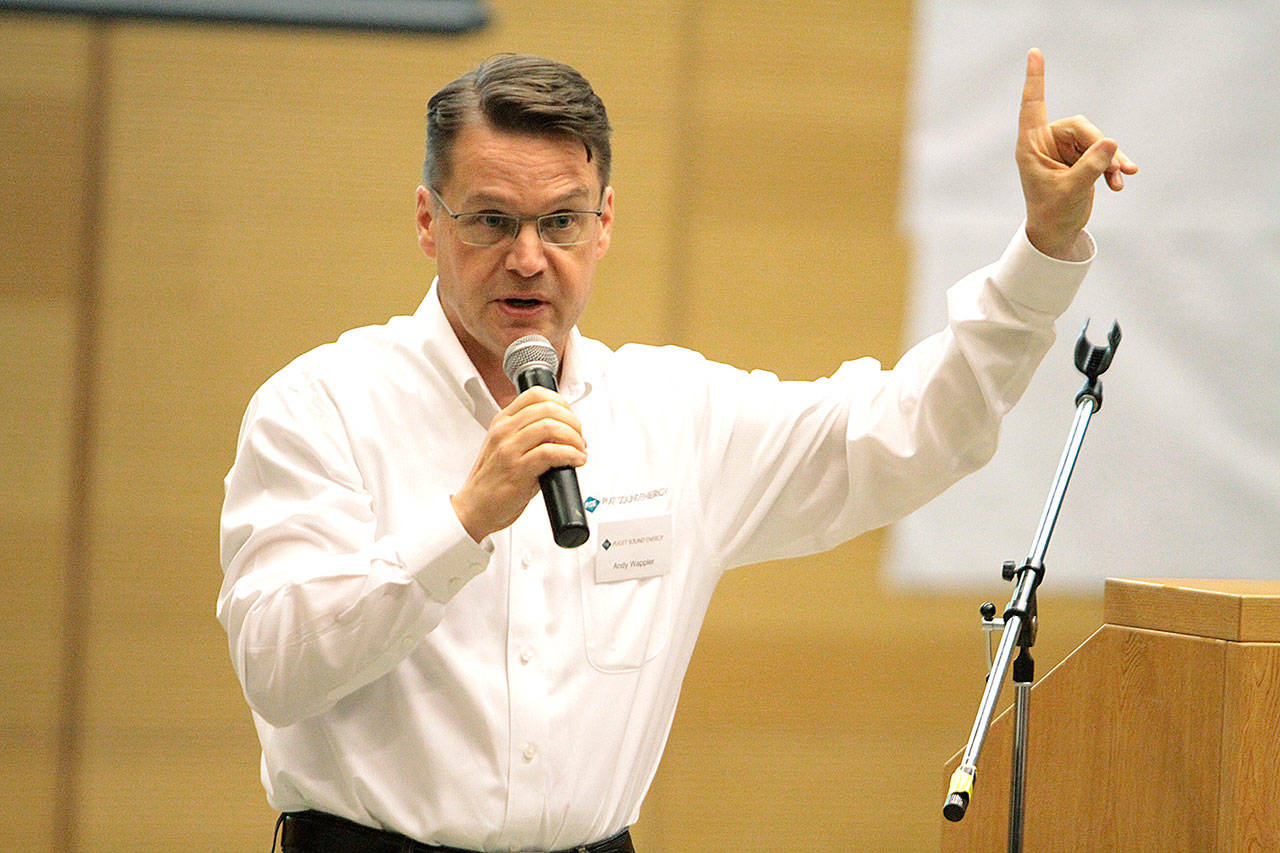Andy Wappler has led a relatively charmed life when it comes to power outages.
At least compared to folks on Bainbridge, that is.
Wappler, a former TV weatherman and currently vice president at Puget Sound Energy, hosted a community meeting with Bainbridge residents late last week to talk about infrastructure upgrades the power company has planned to improve power reliability on the island.
A chunky crowd of roughly 90 people gathered in the commons at Bainbridge High to get details about PSE’s work to keep the lights on.
In contrast to the rest of Kitsap County, and PSE’s entire service region, Bainbridge has endured significantly more power outages in recent years. Wappler displayed a chart that showed an average of one or two outages a year in Kitsap County between 2013 and 2017, while the numbers for Bainbridge, and the Winslow area, surpassed five or six outages in some years.
“Electric reliability needs to be improved,” he said.
“We want to fix it. We have a plan to fix it,” Wappler added.
At his home in Redmond, where he’s lived since 2003, “I have had one outage that has lasted more than two hours.”
“Everybody else who has had one outage in the last 17 years that’s lasted two hours — raise your hands,” Wappler asked the crowd.
After a long pause, a single hand went up.
“He’s lying; I don’t believe it,” Wappler quipped.
PSE’s plan, Wappler said, is a unique solution for Bainbridge Island that will use new technology as well as improvements to the power grid.
The power grid on the island currently is not looped, and has a “missing link” between the Winslow and Murden Cove substations.
PSE officials said the infrastructure improvement package centers on a building a new transmission line to “close the loop” and connect the Murden Cove Substation to the island’s south end (which will cover roughly two thirds of the island’s power system that lacks backup transmission power); a new 3.3 megawatt battery energy system at the Murden Cove site for added backup capacity; and targeted programs that will focus on conservation and demand-response programs.
After a new line is built between the substations, each one will be connected to two transmission lines, so if one line goes out, electricity will still flow to customers through the other line.
Officials said the proposed plan would cut down on the number of power outages, but also meet increasing energy demands, including supplying state ferries with power when Washington State Ferries modifies its vessels to hybrid, fuel-electric powered systems.
The new “battery energy storage system” at PSE’s Murden Cove property will look like a series of shipping containers, probably numbering seven or eight. That backup system is a “non-wire solution” that will provide a full output of needed power for Bainbridge for two hours, officials said, that will help avoid the need for a fourth island substation for 10 to 20 years.
The addition of capacity is needed to not only handle the 10 megawatts required for the state’s repowered ferry fleet, but also a load growth of 4.6 megawatts that will come from Bainbridge residents’ increasing power consumption.
The island’s population will continue to grow, officials said, and people are moving into bigger homes with an ever-increasing array of electric-powered devices.
A needs assessment for the island’s power grid was released by PSE last week. According to the report, the company is serving 12,400 customer accounts (with a current island population of 24,400).
But an examination of the “Winslow Tap” transmission line — which connects the Port Madison substation to the Winslow substation — discovered that over half of the power poles on the line will be need to be replaced over the next three years.
Nearly 70 percent of outages in recent years were due to problems with the Winslow Tap line, with the rest caused by troubles with the lines that bring power onto the island.
Trees falling on lines are also a major cause of outages.
PSE officials said the route for the new transmission line between Murden Cove and Winslow, the “missing link,” has not yet been mapped.
Community input for the location of the new power lines will start in early 2020.
There will also be substantial work on the Winslow Tap line, the transmission line built in 1960 that stretches from the Port Madison substation to the substation in Winslow.
“It’s old and, frankly, needs to be replaced,” said Jens Nedrud, a manager of system planning at PSE.
An inspection of the line found that nearly half of the “wishbone” style cross arms that crown the power poles need to be replaced.
Not replacing the line, the PSE analysis notes, would lead to “unplanned outages and emergency repairs” in coming years.
The battery project at Murden Cove is expected to be up and running by 2022.
It won’t be until 2023 that the Winslow Tap line is rebuilt, PSE officials said, and the new loop link to complete the north-south circle won’t be finished before 2024.
During a question-and-answer session, people asked why PSE wasn’t planning to put more lines underground, and whether solar panels could be used to supply some of the island’s power needs.
Others asked what the utility was doing in response to global climate change.
PSE officials noted that solar panels don’t provide power during times of peak demand, on cold winter mornings and evenings, and that cities where lines are buried must pay the added costs of installing underground lines.
Officials also noted that PSE was reducing its carbon footprint and had worked with state lawmakers on legislation that requires 100 percent clean electricity.


